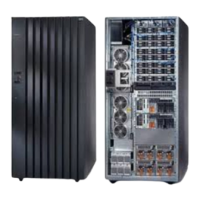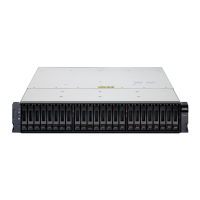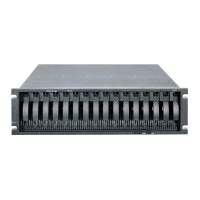Attention: When connecting storage expansion enclosures, it is recommended
that you use the tens digit (x10) enclosure ID setting to distinguish different
redundant loops and use the ones digit (x1) enclosure ID setting to distinguish
storage expansion enclosures IDs within a redundant loop. If you do not set the
single digit value of the enclosure IDs to be unique among storage expansion
enclosures (including the DS4000 storage subsystem with drives installed) in a
redundant drive channel/loop pair, then drive loop errors might be randomly posted
in the DS4000 subsystem Major Event Log (MEL) when you intermix different types
of storage expansion enclosures in a redundant drive loop pair (such as an EXP100
with an EXP810). For example, in a DS4800 configuration with 16 storage
expansion enclosures distributed equally behind the four controller drive ports, the
recommended enclosure ID settings for the enclosures are shown in Table 28.
Table 28. Recommended enclosure ID settings scheme
Enclosure ID
behind the first
controller drive
port
Enclosure ID
behind the
second
controller drive
port
Enclosure ID
behind the third
controller drive
port
Enclosure ID
behind the
fourth controller
drive port
Enclosure 1 00 04 10 14
Enclosure 2 01 05 11 15
Enclosure 3 02 06 12 16
Enclosure 4 03 07 13 17
The DS4800 normally ships with an enclosure ID outside the range of 00–77.
However, if your DS4800 enclosure ID was set to a value within the range of
00–77, it may be in conflict with the enclosure ID of one of the EXP100 or EXP710
drive expansion enclosures that you are trying to attach to the DS4800. If this is the
case, the amber ID Conflict LED on the storage expansion enclosure will light up
after you power on the storage subsystem.
Give each storage expansion enclosure in a redundant drive channel pair a unique
ones digit (x1) ID. This setting will enforce hard AL_PAs (unchangeable between
fibre channel Loop Initializations [LIPs]) for the drives and facilitate drive channel
problem troubleshooting in the event of an error. If the ones digits are not unique,
two or more devices will have the same hard AL_PA. In such a case, the DS4800
controller will use soft AL_PAs for the devices that have identical hard AL_PAs.
The problem with soft addressing is that addresses may change between LIPs. This
possibility increases the difficulty of troubleshooting drive channel problems, since
one cannot easily ascertain whether the same device with a different address or a
different device may be causing a problem.
Connecting hosts to the DS4800
The DS4800 supports redundant connections to up to four hosts. To ensure full
protection against the loss of any one fibre channel path from the host servers to
the DS4800 Storage Subsystem, always use redundant host connections by
connecting each host to the appropriate single-ported host channels on both RAID
controllers A and B.
To connect a host adapter to the DS4800 RAID controllers, perform the following
steps:
Chapter 3. Cabling the storage subsystem 87
|
|
|
|
|
|
|
|
|
|
|
|
|
|
|
|
|
|
|
|
|
|
|
|
|
|
|
|
|
|
|
|
|||||
|||||
|||||
|||||
|
|
|
|
|
|
|

